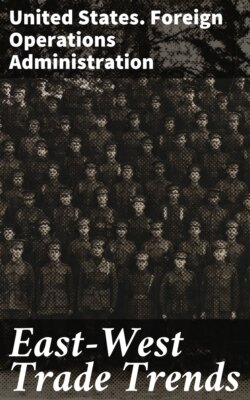Читать книгу East-West Trade Trends - United States. Foreign Operations Administration - Страница 10
CHAPTER II
ОглавлениеThe New Regime and the Consumer
After Stalin, the Soviet leadership was taken up by a group of top party officials. Georgi M. Malenkov was the Premier and the most influential, but apparently several other men held important shares of the responsibility and the power. This elite group included, with varying degrees of personal influence, Beria (temporarily), Molotov, Khrushchev, Voroshilov, Bulganin, Kaganovich, and Mikoyan. None of this new group was new to Soviet leadership. All had been close lieutenants of Stalin. All are known to have had important roles in previous policy formulation, and in directing key operations.
The system that this group took over in the U. S. S. R. was their own as well as Stalin’s creation. Under this system, the economy is organized along authoritarian lines and characterized by state ownership of the means of production and state planning of practically all economic activity. It is the Central Committee of the Communist party which lays down the economic and social policies which the state production plans are desired to implement. The new regime modified this system in no essential respect.
In addition to inheriting the system, Malenkov and his associates inherited economic policies and economic conditions which they themselves had helped to create.
In the U.S.S.R., as we have seen, Soviet economic policy had long been to force industrialization by every means. And this objective required such a concentration of capital investment—both civilian and military—as to deprive the growing population of advances in living standards commensurate with the overall expansion of the Soviet economy. That is another way of saying they took it out of the people’s hides.
Each of the European satellites, too, had undertaken, under Soviet direction, to develop an economic structure similar to that of the Soviet Union. By 1953 all foreign trade, nearly all industry, and a very substantial portion of domestic trade had been nationalized in those countries. Where collectivization of agriculture was not completed, the Government controlled agriculture by means of centralized planning and a system of compulsory deliveries. Each satellite government had drawn up a long-term comprehensive economic plan which, like that of the U.S.S.R., emphasized rapid industrialization.
These developments brought the Communist leaders many serious problems—and the people many deprivations. Before the war, as independent states, most of these satellite countries had devoted a much higher percentage of resources to the consumer sectors of their economies than was customary for the U.S.S.R. When the Communists took control, belts were tightened. The standards of living of the satellite peoples began to decline toward the low levels long prevalent in the U.S.S.R. But denying the satellite peoples the fruits of their labors, in imitation of Moscow patterns, still did not bring the overambitious war-economy plans to success. Agriculture and industry both had difficulty in keeping pace. The world has heard how the transformation of satellite agriculture into the Soviet pattern was impeded by the opposition of the rural populations to collectivization and by the difficulties of mechanizing farm output; how shortages of raw materials slowed the textile program in Czechoslovakia and the electric power industry in Hungary; how the mining and metallurgical industries lagged in some areas; how the rights of labor were obliterated in the attempt to shift manpower into heavy industry; how purges furnished scapegoats for Communist failures.
